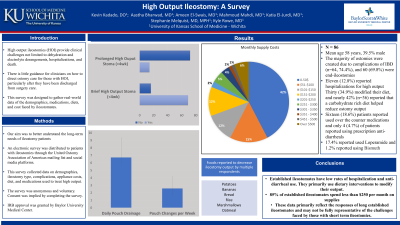Tuesday Poster Session
Category: IBD
P3582 - High Output Ileostomy: A Survey
Tuesday, October 24, 2023
10:30 AM - 4:00 PM PT
Location: Exhibit Hall

Has Audio

Kevin Kadado, DO
University of Kansas School of Medicine
Wichita, KS
Presenting Author(s)
Kevin Kadado, DO, Aastha Bharwad, MD, Ameen El-Swais, MD, Mahmoud Mahdi, MD, Katia El Jurdi, MD, MSc, Stephanie J. Melquist, MD, MPH, Daly Al-Hadeethi, MD, Kyle Rowe, MD
University of Kansas School of Medicine, Wichita, KS
Introduction: High output ileostomies (HOI) provide clinical challenges not limited to dehydration and electrolyte derangements, hospitalizations, and death. There is little guidance for clinicians on how to direct ostomy care for those with HOI, particularly after they have been discharged from surgery care. This survey was designed to gather real-world data of the demographics, medications, diets, and cost faced by ileostomates.
Methods: Our aim was to better understand the long-term needs of HOI patients. An electronic survey was distributed to patients with high output ileostomies through the United Ostomy Association of Americas mailing list and social media platforms. This survey collected data on demographics, ileostomy type, complications, appliance costs, diet, and medications used to treat high output. The survey was anonymous and voluntary. Consent was implied by completing the survey. IRB approval was granted by Baylor University Medical Center.
Results: Eighty-six people completed the survey (mean age 58 years, 34 males). The majority of HOI were created due to complications of IBD. (n=64, 74.4%), and 60 (69.8%) were end-ileostomies. Most experienced brief HOI (< 4 weeks of symptoms) (n=69, 80.2%), and 14 (16.3%) prolonged HOI ( > 4 weeks of symptoms). Eleven (12.8%) required hospitalization. The cost of ostomy supplies varied, with 85% spending 0-250 dollars per month and 16.5% ≥ 251 dollars. Thirty (34.9%) had to modify their diet, 16 (18.6%) used over the counter (OTC) medications, and 4 (4.7%) used prescription medication. The most common OTC was loperamide (17.4%) Prescription medications were reported by 4 patients, 3.5% of which were diphenoxylate/atropine. Nearly 42% of people (n=36) reported using high carbohydrate foods to reduce ostomy output (Table 1).
Discussion: We found most patients had high output lasting < 4 weeks. Use of OTC and prescription medications was low, most used was loperamide. More than 30% of patients had to modify their diet and reported carbohydrate-rich foods can slow output. Hospitalization was reported in only 12 people. This study shows real-world data for clinicians to better understand the needs of and counsel their HIO patients. Cost of ostomy supplies varies but can exceed $6000 per year. These data primarily reflect the responses of long established ileostomates and may not be fully representative of the challenges faced by those with short term ileostomies.
Disclosures:
Kevin Kadado, DO, Aastha Bharwad, MD, Ameen El-Swais, MD, Mahmoud Mahdi, MD, Katia El Jurdi, MD, MSc, Stephanie J. Melquist, MD, MPH, Daly Al-Hadeethi, MD, Kyle Rowe, MD. P3582 - High Output Ileostomy: A Survey, ACG 2023 Annual Scientific Meeting Abstracts. Vancouver, BC, Canada: American College of Gastroenterology.
University of Kansas School of Medicine, Wichita, KS
Introduction: High output ileostomies (HOI) provide clinical challenges not limited to dehydration and electrolyte derangements, hospitalizations, and death. There is little guidance for clinicians on how to direct ostomy care for those with HOI, particularly after they have been discharged from surgery care. This survey was designed to gather real-world data of the demographics, medications, diets, and cost faced by ileostomates.
Methods: Our aim was to better understand the long-term needs of HOI patients. An electronic survey was distributed to patients with high output ileostomies through the United Ostomy Association of Americas mailing list and social media platforms. This survey collected data on demographics, ileostomy type, complications, appliance costs, diet, and medications used to treat high output. The survey was anonymous and voluntary. Consent was implied by completing the survey. IRB approval was granted by Baylor University Medical Center.
Results: Eighty-six people completed the survey (mean age 58 years, 34 males). The majority of HOI were created due to complications of IBD. (n=64, 74.4%), and 60 (69.8%) were end-ileostomies. Most experienced brief HOI (< 4 weeks of symptoms) (n=69, 80.2%), and 14 (16.3%) prolonged HOI ( > 4 weeks of symptoms). Eleven (12.8%) required hospitalization. The cost of ostomy supplies varied, with 85% spending 0-250 dollars per month and 16.5% ≥ 251 dollars. Thirty (34.9%) had to modify their diet, 16 (18.6%) used over the counter (OTC) medications, and 4 (4.7%) used prescription medication. The most common OTC was loperamide (17.4%) Prescription medications were reported by 4 patients, 3.5% of which were diphenoxylate/atropine. Nearly 42% of people (n=36) reported using high carbohydrate foods to reduce ostomy output (Table 1).
Discussion: We found most patients had high output lasting < 4 weeks. Use of OTC and prescription medications was low, most used was loperamide. More than 30% of patients had to modify their diet and reported carbohydrate-rich foods can slow output. Hospitalization was reported in only 12 people. This study shows real-world data for clinicians to better understand the needs of and counsel their HIO patients. Cost of ostomy supplies varies but can exceed $6000 per year. These data primarily reflect the responses of long established ileostomates and may not be fully representative of the challenges faced by those with short term ileostomies.
Disclosures:
Kevin Kadado indicated no relevant financial relationships.
Aastha Bharwad indicated no relevant financial relationships.
Ameen El-Swais indicated no relevant financial relationships.
Mahmoud Mahdi indicated no relevant financial relationships.
Katia El Jurdi indicated no relevant financial relationships.
Stephanie Melquist indicated no relevant financial relationships.
Daly Al-Hadeethi indicated no relevant financial relationships.
Kyle Rowe indicated no relevant financial relationships.
Kevin Kadado, DO, Aastha Bharwad, MD, Ameen El-Swais, MD, Mahmoud Mahdi, MD, Katia El Jurdi, MD, MSc, Stephanie J. Melquist, MD, MPH, Daly Al-Hadeethi, MD, Kyle Rowe, MD. P3582 - High Output Ileostomy: A Survey, ACG 2023 Annual Scientific Meeting Abstracts. Vancouver, BC, Canada: American College of Gastroenterology.
